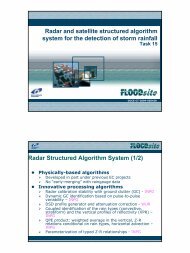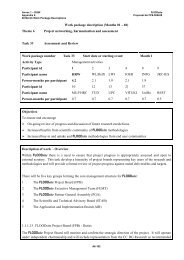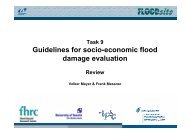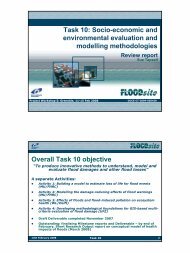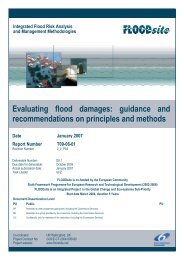Evacuation and traffic management (full report) - FLOODsite
Evacuation and traffic management (full report) - FLOODsite
Evacuation and traffic management (full report) - FLOODsite
You also want an ePaper? Increase the reach of your titles
YUMPU automatically turns print PDFs into web optimized ePapers that Google loves.
Task 17 <strong>Evacuation</strong> D17-1<br />
Contract No:GOCE-CT-2004-505420<br />
effect of overtopping waves (the inner slope). In these cases a temporary additional protection with<br />
s<strong>and</strong>bags may be necessary.<br />
There are also dikes that are sensitive to piping. This is where seepage through the dike may cause an<br />
internal erosion of the dike core material <strong>and</strong> the formation of pipes through which a water flow may<br />
develop that can affect the dike stability. The dike sections that are vulnerable to piping are usually<br />
known to the authorities. At such locations s<strong>and</strong> bags are placed on the inner dike toe to provide a<br />
counter pressure to reduce piping.<br />
Activation of retention areas<br />
The use of retention areas to reduce flood levels has been seriously studied by a Governmental<br />
Commission. The commission's <strong>report</strong> was submitted in 2002. It considers the use <strong>and</strong> necessity of<br />
retention areas. Areas where a controlled inundation is accepted in a critical flood situation, to prevent<br />
an uncontrolled inundation at some other place. This is known in Dutch as a 'noodoverloopgebieden'<br />
i.e. emergency inundation areas. The <strong>report</strong> considered a number of potentially suitable areas along<br />
the Rhine <strong>and</strong> Meuse. However, currently no retention area has the final status of<br />
‘noodoverloopgebied’ that will be used in a future flood emergency. The reasons for this are various<br />
including the financial compensation required to pay the affected inhabitants, the critical timing to<br />
obtain an optimum effect of a retention area <strong>and</strong> because nobody wants to inhabit these areas.<br />
Closure of storm surge barriers <strong>and</strong> gates<br />
There are three structures in the Netherl<strong>and</strong>s that have a key role when a there is a severe threat of<br />
flooding. They are all located in the western part of the Netherl<strong>and</strong>s, where the threat from the North<br />
Sea is dominant:<br />
• The Holl<strong>and</strong>se IJssel barrier (1958) located just east of Rotterdam. It was constructed after the<br />
1953 flood disaster for extra protection of the low areas along the Holl<strong>and</strong>se IJssel which is under<br />
normal conditions in open connection with North Sea. With a level of down to 6 m below sealevel<br />
this area is in fact the lowest of the country. During the 1953 disaster the stability of some<br />
dike sections there was critical, they nearly failed. One dike section was just prevented from<br />
collapsing by sinking a river-vessel on its slope.<br />
• The Eastern Schelde storm surge barrier (1986) protects the dikes along the Eastern Schelde<br />
estuary. It is closed as soon as the North Sea reaches a certain level. It was constructed as an<br />
alternative for the originally planned enclosure dike, to preserve the tidal regime <strong>and</strong> its related<br />
very special ecological system, but also to maintain the high value fishery <strong>and</strong> aquaculture area<br />
(e.g. mussels, oysters).<br />
• The Maeslant storm surge barrier (1997) provides extra protection of the urban <strong>and</strong> industrial<br />
areas along the Rotterdam Waterway.<br />
The expression 'extra protection' as used here needs some clarification. The primary dikes along the<br />
dike ring form the primary water defence. However, the safety given by either of these barriers could<br />
compensate the need for further heightening of dike sections to comply with the safety levels in the<br />
Flood Protection Act. Dikes in this part of the country are often in densely built urban areas, <strong>and</strong><br />
consequently dike improvement is a complicated <strong>and</strong> expensive matter.<br />
Raising demountable flood walls <strong>and</strong> pumping<br />
Demountable flood walls are mainly applied in the Meuse basin in the province of Limburg. As soon<br />
as a local warning level is reached the demountable flood wall units are mobilised <strong>and</strong> put in place.<br />
They usually protect only small areas such as quays or streets along the river. The height of these<br />
structures does not usually exceed more than one metre. In fact coupures without a permanent closing<br />
device also belong to this category. Pumping is usually only applied to get rid of water that leaks<br />
through (temporary) closing devices, e.g. s<strong>and</strong> bags. It is not used as a measure on its own.<br />
T17_07_02_<strong>Evacuation</strong>_<strong>and</strong>_<strong>traffic</strong>_<strong>management</strong>_D17_1_V4_4_P01.doc 19 03 2008<br />
24




